
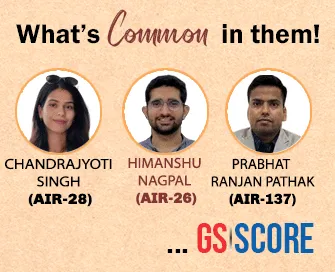
19th May 2025 (13 Topics)
Mains Issues
Context
India has imposed new port restrictions on imports from Bangladesh—especially on ready-made garments—following Bangladesh's move to block Indian yarn exports via land ports. This marks a significant escalation in trade tensions between the two neighbours.
What has Triggered Recent Trade Friction?
- Restrictions on Garments from Bangladesh: India restricted imports of Bangladeshi garments to protect its domestic textile industry and attract labour-intensive manufacturing jobs to its own economy. Indian manufacturers have long complained that Bangladesh enjoys unfair price advantages, due to:
|
Indian Seaports Allowed for Certain Bangladesh Exports:
|
- Duty-free fabric imports from China
- Export subsidies by the Bangladeshi government
- No GST on imported inputs (compared to India’s 5% GST on fabric)
- Termination of Transhipment Facility: India ended a five-year-old transhipment arrangement that allowed Bangladesh to use Indian ports and land routes to export goods to third countries. This was a key logistics channel for Bangladesh’s trade with the West, especially the EU and UK.
- Bangladesh's Port Restrictions: Bangladesh has restricted India’s yarn exports via land ports, now allowing only seaport-based exports. Yarn is vital for Bangladesh’s garments industry, and land ports offer quicker, cheaper access.
Concerns for India
- Regional imbalance: This deterioration is not just about trade; it’s also about strategic influence and regional balance. India sees Bangladesh as a key buffer and partner in the Northeast. Any shift in Dhaka’s foreign alignment directly affects India’s security, connectivity projects, and regional diplomacy.
- Loss of Influence in a Key Neighbour: Bangladesh’s pivot to China could undermine India’s leadership role in the region. It may impact India’s Act East and Neighbourhood First policies.
- China Involvement: China has given duty-free access to 97% of Bangladeshi exports since 2020. It has invested heavily in infrastructure (roads, ports, bridges) and is also Bangladesh’s main military supplier. A USD 2.1 billion deal signed in March 2025 further cemented this strategic realignment. Chinese involvement in sensitive projects like the Teesta River development adds to India’s concern
- Regional Trade Competition: China’s support helps Bangladesh stay competitive in garments, even as India tries to boost its own exports under new FTAs. India could lose out on labour-intensive FDI if it doesn’t become more cost-effective.
Benefits for India
- Protecting Domestic Industry: By limiting cheap imports from Bangladesh, India aims to:
- Boost its own textile manufacturing
- Attract labour-intensive jobs
- Ensure a level playing field for Indian manufacturers
- Reviving Northeast India’s Industry: Bangladeshi imports through land ports in the Northeast stifle local industry and limit trade to basic agricultural produce. By restricting imports via these routes, the government aims to promote self-reliance (Atmanirbhar Bharat) and encourage industrial development in the region.
- Rebalancing the Trade Relationship: Bangladesh cannot “cherry-pick” trade benefits while restricting Indian exports. The withdrawal of the transshipment facility, which allowed Bangladesh to export to third countries through Indian ports and airports, is also part of this rebalancing effort.
- Access to key markets: India is signing FTAs with the UK, EU, and EFTA to build alternative garment export routes. This also explains why it is less dependent on Bangladeshi textile imports now.
- Kaladan Multi-Modal Transit Transport Project: This shift has forced India to revive and fast-track alternate routes, particularly through Myanmar, via the Kaladan Multi-Modal Transit Transport Project (KMMTTP). KMMTTP, launched in 2008 as part of India’s Look East/Act East Policy, this project is a multi-modal connectivity initiative that links:
- Kolkata (India) to Sittwe Port (Myanmar) by sea (539 km)
- From Sittwe to Paletwa via the Kaladan river (158 km)
- Then by road to Zorinpui (Mizoram) through a 108 km highway
- Finally, it connects to Aizwal and Shillong via existing and planned roads
- Zorinpui is the India-Myanmar border point in Mizoram.
- This route bypasses Bangladesh entirely and can cut travel time by 3–4 days and reduce distance by 1,000 km compared to traditional routes through Siliguri.
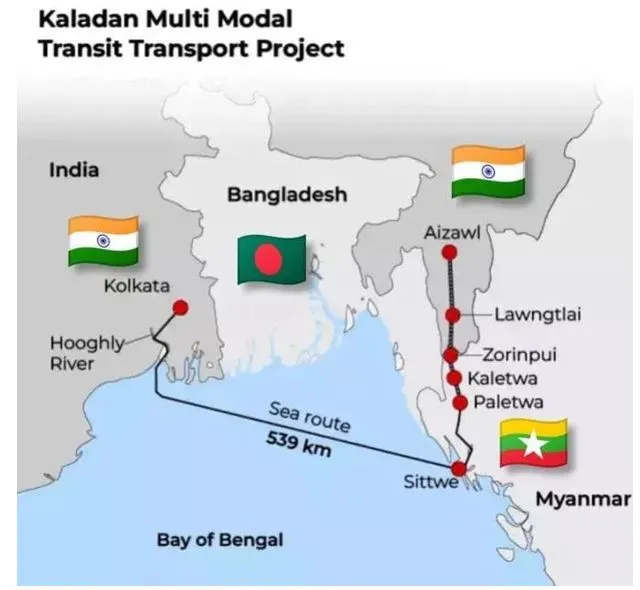
India-Bangladesh Relations
|


Mains Issues
Context
New Caledonia is a French territory in the South Pacific with a long-standing independence movement led by its Indigenous Kanak population. Tensions have resurfaced in 2024 after failed negotiations over its political future and voting rights reforms.
Where and what is New Caledonia?
- New Caledonia is a small group of islands in the southwest Pacific Ocean, around 1,200 km east of Australia.
- It is a French overseas territory with a population of about 271,000.
- While geographically part of Melanesia, it has been under French rule since 1853.
- Even today, it remains politically tied to France, but the question of whether it should remain a part of France or become independent has been a deeply emotional and political issue — especially for the Indigenous Kanak people, who have long demanded sovereignty.
- Roots of the Conflict
- France colonised the islands as a penal colony. The Kanak people were dispossessed of their land, culture, and political autonomy.
- Over time, especially during the 20th century, the Kanak movement for self-rule gained strength. It took a violent turn in the 1980s when civil conflict broke out between Kanak pro-independence groups and loyalists (those who wanted to stay with France).
- This tension led to the 1988 Matignon Accords and later to the 1998 Nouméa Accord — a turning point in the political journey of New Caledonia.
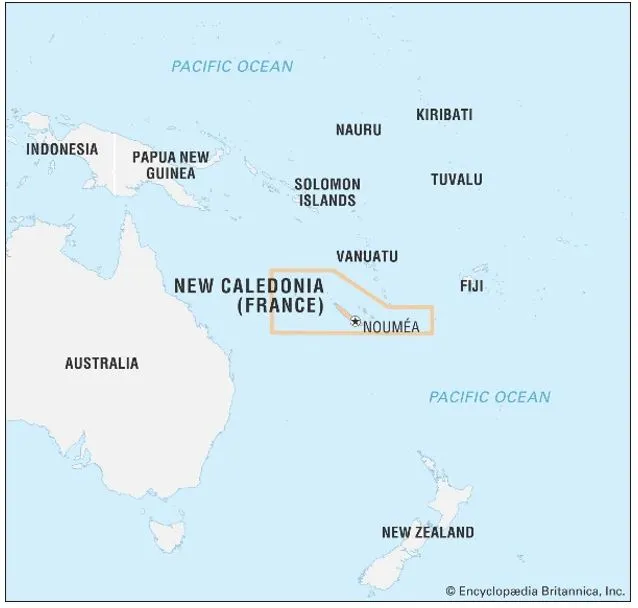
What was the Nouméa Accord (1998)?
- The Nouméa Accord recognised the colonial trauma of the Kanak people and aimed to provide them with greater autonomy.
- It created a unique political arrangement — a “sui generis” status:
- A local Congress with legislative powers
- Restricted voting rights to long-term residents (to protect Kanak political strength)
- Own citizenship status (New Caledonian)
- Most importantly, it agreed on three referendums on independence, to be held from 2018 to 2021.
- Results of the Referendums:
- 2018 – Independence rejected (57% No)
- 2020 – Rejected again (53% No)
- 2021 – Overwhelming rejection (96% No) — BUT this was boycotted by the Kanak leaders, who were mourning during the COVID pandemic and asked for postponement, which was denied by France.
- So, although all three technically rejected independence, the legitimacy of the third vote is heavily disputed.
Why is independence still demanded?
- The Kanak and Socialist National Liberation Front (FLNKS) and other pro-independence groups believe:
- The political and economic system remains unequal, dominated by French settlers and loyalists.
- Kanaks face higher unemployment, poorer education and health indicators.
- Despite autonomy, key functions like defence, foreign policy, judiciary and currency are still under Paris’ control.
- The cultural identity of Kanaks, their land rights, and future as a people feel insecure within the French system.
- Thus, for many Kanaks, independence is not just a political goal but a way to reclaim identity, dignity, and full self-governance.
- Recent political crisis in 2024? After the disputed 2021 referendum, no clear political roadmap was agreed upon. Tensions simmered. In 2024, France proposed to “unfreeze” the electoral rolls — meaning more recent French migrants to the islands would be allowed to vote in future provincial elections.
- In this charged atmosphere, France tried to mediate a new “middle path” — known as “sovereignty in partnership.”
What is “Sovereignty in Partnership” and Why Did Talks Fail?
- The French proposal offered:
- Broad internal autonomy for New Caledonia
- Control over local governance, judicial matters, and international representation
- BUT with key powers delegated back to France under mutual agreement
- This was meant to offer symbolic sovereignty without total separation — a model used in places like the Cook Islands (with New Zealand) or the Faroe Islands (with Denmark).
- But the plan collapsed due to rejection by hardline loyalist factions.
- In contrast, some loyalists proposed partitioning New Caledonia, with:
- The Kanak-dominated North and Loyalty Islands becoming autonomous
- The wealthier, French-dominated South staying with France
- This was rejected by the French government (which wants New Caledonia to remain united) and outright condemned by the Kanak side as an idea “akin to apartheid.”


Mains Issues
Context
The newly sworn-in Chief Justice of India (CJI), Bhushan Ramkrishna Gavai, made a significant remark that not the judiciary, nor the executive, but the Constitution of India is supreme. It raises deeper constitutional and democratic concerns about the relationship between the three organs of the state and the importance of mutual respect in a healthy democracy.
What is Separation of Powers?
- The Constitution outlines a clear separation of powers:
- Legislature: Makes laws
- Executive: Implements laws and manages administration
- Judiciary: Interprets laws and protects rights
- However, these functions inevitably overlap in practice, requiring each organ to cooperate without encroaching on the other's space.
- This is where institutional discipline and mutual understanding become critical.
- No branch can claim superiority—but all must act in a way that upholds the supremacy of the Constitution.
Why Institutional Respect Matters?
- Foundation of Constitutional Governance: Respect between organs of the state is not about individual positions—it's about the dignity of constitutional offices. When one branch fails to acknowledge the role or presence of another, it sends a signal that collaboration and mutual accountability may be weakening.
- Symbolism and Legitimacy: The way institutions treat each other is symbolic of how constitutional values are lived out in practice. Disregard for established conventions (like welcoming constitutional dignitaries) undermines the moral legitimacy of the institutions involved.
- Preventing Institutional Friction: Indian democracy has witnessed instances where friction between executive and judiciary—or between Centre and States—has created confusion or even constitutional crises. Proactive institutional courtesy helps build confidence and prevent escalation.
- Constitutional Morality vs. Procedural Formality: True constitutional governance isn’t just about laws and orders—it’s also about constitutional morality: the unwritten norms of respect, restraint, and recognition. These moral values are essential for the long-term health of democratic institutions.
Constitutional Supremacy: What It Means in Practice?
- The Constitution is the highest authority in India—not the Parliament, not the Prime Minister, not the Chief Justice.
- All laws, decisions, and actions by any branch of government must align with constitutional principles such as equality, rule of law, federalism, and justice.
- Even the Supreme Court’s powers under Article 142, while broad, must be used within the constitutional framework and not beyond it.
- Similarly, executive authority is subject to judicial review, and the legislature’s actions are limited by constitutional amendments and checks.
In other words, each institution derives its legitimacy from the Constitution—and none can act as if it exists above it.
Fact-Box:Basic features of Constitutional Supremacy are as follows:
Constitutional Provisions Supporting Supremacy of Constitution:
|


Mains Issues
Context
India’s maritime strategy is shifting from a domestic focus to establishing a global presence in port development, beginning with Chabahar Port in Iran and expanding to Africa (Tanzania) and neighbouring countries like Myanmar and Sri Lanka. This marks a strategic move to enhance trade access, regional influence, and global connectivity.
Why Chabahar Port matters?
Chabahar port in southeastern Iran, developed and operated by India, is a strategic asset for multiple reasons:
- Gateway to Central Asia and Afghanistan: It provides India an alternative route to Afghanistan, bypassing Pakistan, and opens up trade corridors to Central Asia through the International North-South Transport Corridor (INSTC).
- Geopolitical leverage: It strengthens India’s presence in the western Indian Ocean, countering China's influence through Gwadar Port (Pakistan).
- Trade hub in the making: Operated by IPGL at the Shahid Beheshti Terminal, container traffic at Chabahar jumped from just 9,126 TEUs in FY23 to 64,245 TEUs by January FY25, and is projected to reach 75,000 TEUs by the end of FY25, with full capacity of 100,000 TEUs by FY26.
India’s expanding focus areas:
- Tanzania: After Chabahar, India is now eyeing Africa’s east coast, especially Tanzania, for port-related ventures. The aim is to support Indian trade, improve connectivity, and balance China’s deep influence in African infrastructure.
- Tanzania’s main ports — Dar es Salaam, Mtwara, Tanga, along with minor ports in Zanzibar and Pemba islands — are strategically located on the Indian Ocean.
- Myanmar – Sittwe Port: Indian Ports Global Ltd (IPGL) is operating the Sittwe port, developed under the Kaladan Multimodal Transit Transport Project. It connects India’s Northeast to Myanmar and the Bay of Bengal, and will eventually link to Thailand and ASEAN trade routes. It helps India counterbalance China’s activities in the region and supports Act East Policy.
- Sri Lanka – Kankesanthurai Port: Indian Ports Global Ltd (IPGL) is helping to develop and operate Kankesanthurai (KKS) port in northern Sri Lanka. A Nagapattinam–KKS ferry service is also planned to boost people-to-people ties and revive old maritime links.
Significance of India’s port expansion
India’s port expansion is not just about logistics — it serves a deeper strategic vision:
- Countering China’s Maritime Silk Road: Through projects like Gwadar (Pakistan), Hambantota (Sri Lanka), and multiple African ports, China is increasing its footprint. India is presenting a non-coercive, development-driven alternative.
- Regional connectivity and soft power: Through joint ventures and MoUs, India promotes a collaborative approach to infrastructure.
- Economic diplomacy: Ports are being used to unlock trade potential with regions like Africa, Central Asia, and ASEAN.


Mains Issues
Context
The recent fire tragedy in Hyderabad’s Gulzar Houz area that claimed 17 lives has once again highlighted systemic gaps in urban disaster preparedness, especially in the context of structural vulnerabilities, non-compliance with safety norms, and inefficient response infrastructure.
Structural Vulnerabilities in Urban Buildings
- Narrow Entrances and Staircases: The affected building had a single, tunnel-like staircase. In case of fire, such structural layouts act as chokepoints, hindering evacuation and rescue efforts.
- Lack of Setbacks: Absence of legally mandated side and rear spaces restricted access for fire tenders and limited ventilation.
- Combustible Materials: Heavy use of wood and lack of fire-retardant materials accelerated smoke accumulation and fire spread.
- Fire Safety Non-Compliance
- No functional fire alarms, extinguishers, or sprinkler systems were installed.
- Absence of fire exits and emergency lighting created chaos during evacuation.
- Deviations from approved building plans indicated systemic regulatory failure.
- National Building Code (NBC) mandates fire safety features in commercial and residential buildings.


Prelims Articles
Context
A Mexican navy tall sailing ship Cuauhtemoc reportedly hit the New York City's Brooklyn Bridge.
About
- The Brooklyn Bridge is a large-scale steel and stone cable-stayed suspension bridge with a central span of 1,595 feet (486m) and a total length of 5,989 Feet (1,25m).
- It was completed in 1883.
- It spans the East River to connect the New York City boroughs of Manhattan and Brooklyn.
- It is one of NYC’s most iconic landmarks.
- It carries over 100,000 vehicles and 32,000 pedestrians daily, and its central walkway is a major tourist draw.
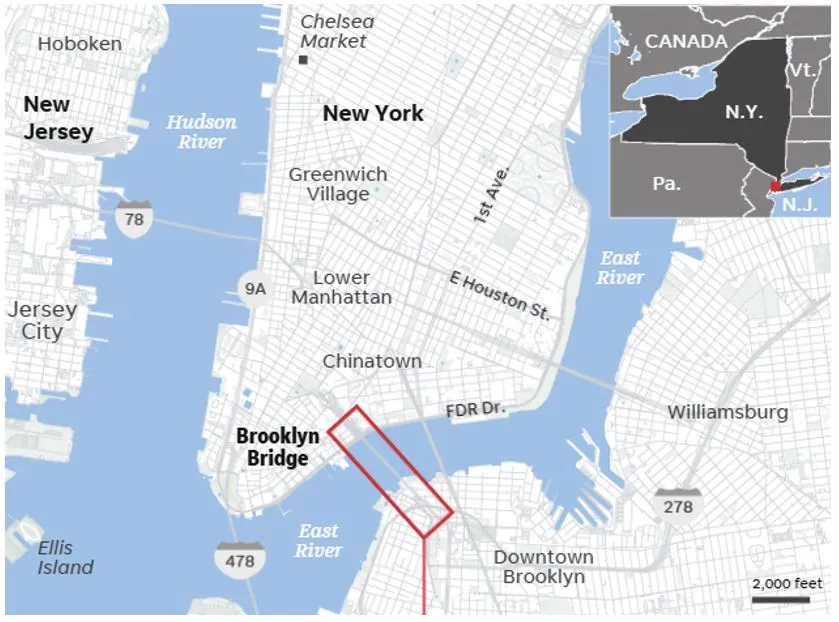
|
About Cuauhtémoc
|


Prelims Articles
Context
The Indian authorities are planning to apprise the Financial Action Task Force (FATF) of the latest evidence related to the terror bases in Pakistan that were destroyed by the defence forces during the precision attacks as part of Operation Sindoor, in the aftermath of the Pahalgam terror attack.
What is FATF?
- The Financial Action Task Force (FATF) is an intergovernmental policy-making body established in 1989 to fight money laundering, terrorist financing, and other related threats to the integrity of the international financial system.
- Headquarters: Paris, France
- FATF works by setting global standards and monitoring compliance through peer reviews.
- Membership: It is a 40-member body. India became a member of FATF in 2010.
- When a country fails to meet these standards, it may be placed either on the:
- Black List: It is given to the countries that FATF considers uncooperative tax havens. These countries are known as Non-Cooperative Countries or Territories (NCCTs).
- Grey List: It is a warning given to the country that it might come on the Black list.
- Grey List countries face increased financial scrutiny, reputational damage, and often economic consequences like reduced foreign investment or stricter IMF lending conditions.
- Pakistan’s FATF History:
- 2008: Pakistan was grey-listed for the first time.
- 2009: It was removed after commitments to reform.
- 2012–2015: Again grey-listed for failing to act against terror networks.
- 2018–2022: Grey-listed due to failure to prosecute UN-designated terror groups like JeM and LeT.
- October 2022: Removed after showing “significant progress,” but FATF urged Pakistan to keep cooperating with the Asia Pacific Group (APG) for reforms in its AML/CFT (Anti-Money Laundering/Combating the Financing of Terrorism)

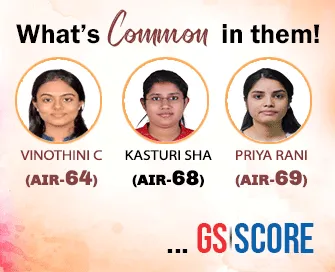
Prelims Articles
Context
Jyoti Rani, a Haryana-based YouTuber with a large following, was arrested for allegedly spying for Pakistan’s intelligence agency (believed to be ISI) under Operation Sindoor. She has been booked under:
- Section 3 & Section 5 of the Official Secrets Act, 1923
- Section 152 of the Bharatiya Nyaya Sanhita (BNS)
Official Secrets Act (OSA), 1923:
- It is a colonial-era legislation meant to protect State secrets, especially related to defence, intelligence, and national security.
- Section 3: Penalties for Spying. This section targets any individual who:
- Gains access to or observes prohibited areas
- Prepares or shares any material (plans, models, documents, etc.) that could benefit an enemy
- Collects or communicates any classified information
- Punishment: Up to 14 years’ imprisonment for offences relating to defence establishments. Up to 3 years in other cases
- Section 5: Wrongful Communication of Information
- Even unauthorised disclosure—whether deliberate or careless—of official secrets is punishable.
- Includes both the giver and receiver of information.
- Punishment: Up to 3 years imprisonment, or fine, or both.
Section 152 of the Bharatiya Nyaya Sanhita (BNS), 2023
- This section criminalizes any act that:
- Encourages separatism
- Incites rebellion or subversive activities
- Endangers India’s sovereignty or unity
- It applies not just to physical acts, but also speech, writing, social media posts, financial aid, etc.
- Punishment: Life imprisonment, or Imprisonment up to 7 years, and fine


Prelims Articles
Context
The explosive growth of Futures & Options (F&O) trading in India has triggered concern among top financial authorities over the high number of retail investors entering the derivatives market without proper knowledge, despite 90% of them incurring losses, according to SEBI’s internal data.
What Are Derivatives?
- A derivative is a financial contract whose value is based on (or "derived" from) the price of something else — called the underlying asset.
- These underlying assets could be:
- Stocks (like Reliance shares)
- Stock market indices (like Nifty 50)
- Commodities (like gold, silver, crude oil)
- Currencies
- Interest rates
- Example: If you have a contract that depends on the future price of crude oil, the price of that contract will move up or down depending on how crude oil prices move in the market.
- Derivatives do not involve actual ownership of the underlying asset. They are more like bets on where the price of an asset will go. This makes them tools for hedging risk, speculation, or leveraged trading.
- Among the most commonly traded derivatives are Futures and Options.
- Futures: It is a contract obligating the buyer to purchase (and the seller to sell) an asset at a predetermined price on a future date.
- Both parties are obligated to execute the contract at expiry unless closed earlier.
- Types: One type – long (buy) or short (sell) futures contracts.
- It requires a margin deposit (a small % of the contract value).
- It is primarily used for hedging by producers/consumers or speculating by traders.
- Profit & Loss: Gains/losses are unlimited and realized daily (marked to market).
- Example: A trader agrees to buy crude oil at USD 80/barrel in 2 months. If prices rise to USD 90, the trader gains USD 10/barrel.
- Options: It is a contract giving the buyer the right (but not obligation) to buy or sell an asset at a specific price before or at expiry.
- Only the seller (writer) is obligated; the buyer can choose whether or not to exercise the option.
- Types: Two types – Call options (right to buy) and Put options (right to sell).
- Buyer pays a premium (non-refundable cost of the option).
- It is used for hedging, speculation, or income generation (by writing options).
- Profit & Loss: Buyers have limited risk (premium paid) and unlimited gain (for calls). Sellers (writers) take more risk depending on the option type.
- Example: A trader buys a call option to buy crude at USD 80. If prices rise to USD 90, the trader can exercise and gain USD 10 – premium paid.
- Futures: It is a contract obligating the buyer to purchase (and the seller to sell) an asset at a predetermined price on a future date.


Prelims Articles
Context
The 101st launch of the Indian Space Research Organisation (ISRO) failed mid-flight during its third stage due to a technical anomaly in the third stage of the PSLV-C61 rocket.
Key Reasons for the Failure:
- Normal Performance of First Two Stages: The launch began successfully. The first and second stages of the four-stage Polar Satellite Launch Vehicle (PSLV) functioned as expected.
- Issue in the Third Stage: During the operation of the third stage, a drop in chamber pressure of the solid rocket motor was observed. This fall in pressure compromised the thrust generation required to propel the vehicle further into the intended Sun Synchronous Polar Orbit (SSPO), leading to mission failure.
- Due to this anomaly, the satellite EOS-09 could not be placed in its intended orbit.
About the EOS-09 Mission:
-
EOS-09 is a remote sensing Earth observation satellite, similar to EOS-04, intended to provide frequent imaging for operational applications like agriculture, forestry, soil moisture, disaster management, and flood monitoring.
- It was equipped with Synthetic Aperture Radar (SAR), capable of capturing high-resolution images regardless of weather or light conditions.
- Intended Orbit: A Sun Synchronous Polar Orbit (SSPO) — crucial for consistent lighting conditions in Earth observation.
- PSLV-C61 was ISRO’s 101st launch, reinforcing the importance and frequency of PSLV in India’s space program.
- The PS4 stage was also designed with Orbit Change Thrusters (OCT) and passivation mechanisms to minimize space debris post-satellite deployment — had the mission succeeded.


Editorials
Context
Former U.S. President Donald Trump recently requested Apple CEO Tim Cook not to expand Apple’s production in India unless the output is solely for Indian markets. This has sparked concerns over India-U.S. trade negotiations and Apple’s global production strategy, particularly as Apple already manufactures 15% of its iPhones in India and plans further expansion.
Implications for India’s Trade and Manufacturing Policy
- Jeopardising Trade Gains: Trump’s demand comes amid India’s efforts to finalise a bilateral trade deal with the U.S., where India is considering lowering tariffs on U.S. goods; his stance may undermine India’s goal of attracting high-end manufacturing.
- Potential Setback to Apple’s India Plans: Apple’s ongoing expansion of production capacity in India could be derailed by political interference, adversely affecting India’s ‘Make in India’ ambitions and electronics export potential.
- Policy Uncertainty as a Barrier: Trump’s unpredictable trade interventions introduce uncertainty for investors, weakening India’s position as a reliable manufacturing hub despite favourable cost advantages.
Corporate Strategy vs. Protectionism
- Dilemma for Apple’s CEO: Tim Cook is caught between national political pressure and corporate profitability, as Apple seeks to diversify its production base amidst rising costs and geopolitical risks in China and the U.S..
- Capitalism and Cost Logic: Corporations like Apple operate on global cost efficiency, not national interest, and choose locations based on labour costs, political stability, and logistical convenience.
- Risks of Tariff-Driven Isolationism: Trump's protectionist push could backfire by deterring foreign firms from investing in the U.S., where labour costs and policy unpredictability create a less competitive manufacturing environment.
Global Market Dynamics and Strategic Autonomy
- Global Production over National Focus: In an era of global supply chains, firms operate on a transnational production logic and resist constraints that limit market flexibility or output deployment.
- Comparative Risk Across Manufacturing Hubs: With China embroiled in trade wars and the S. grappling with erratic policy shifts, India appears to offer relative stability, which can attract long-term investment—unless disrupted by external political pressure.
- Negative Signal for Global Investors: Trump's move sends a message that geopolitical interference in business decisions is a credible threat, discouraging global capital from making strategic manufacturing commitments.
Practice Question
Q. In light of recent developments surrounding Apple’s manufacturing expansion, critically examine the impact of foreign political pressures on India’s trade and industrial policy. What challenges does this pose to India’s ambition of becoming a global manufacturing hub under the Make in India initiative?

Editorials
Context
The Government of India has proposed to include caste enumeration in the upcoming decennial Census, reigniting debates on the efficacy, intent, and utility of caste-based data in policymaking for social justice and welfare distribution.
Role and Merits of Caste Census
- Empirical Basis for Policy: Caste census can offer data-backed insights into socio-economic conditions of OBCs, aiding targeted affirmative action and legitimising welfare programmes in courts.
- Intra-OBC Stratification: Disaggregated data can identify Extremely Backward Classes (EBCs) within OBCs and address intra-group disparities in representation and welfare.
- Institutionalising Enumeration: In a socially diverse country, routine caste enumeration ensures regular monitoring of marginalised communities' progress.
Limitations and Institutional Concerns
- Misplaced Policy Pivot: Elevating Census data as the central or sole basis for social justice policymaking misconstrues the Census’ factual role.
- Overburdening the Census Machinery: Expecting political reform from a statistical institution politicises its neutral mandate, risking institutional integrity.
- Historical Precedent of Policy without Data: Reforms like Mandal recommendations and EWS reservations were executed without exhaustive caste-based datasets, driven more by political resolve.
- Abundant Data Already Available: Surveys like SECC, NCRB, NFHS and the Bihar caste survey already document caste-linked inequalities and crime rates.
- Underrepresentation in Key Sectors: Despite evidence, SCs/STs/OBCs remain underrepresented in private corporate sectors, media, judiciary, and elite education.
- Policy Vacuum and Lack of Will: No significant central policy reform has followed existing caste data; social justice is stalled by absence of political will, not information scarcity.
Practice Question
Q. Critically evaluate the role of caste-based census in ensuring social justice. Can empirical data substitute political will in addressing historical disadvantages?


Editorials
Context
The failure of ISRO’s PSLV-C61 mission to place the EOS-09 earth observation satellite into a sun-synchronous orbit has raised critical concerns about India’s satellite launch reliability, especially amidst growing military and civilian demand for real-time surveillance and strategic data.
Technical and Strategic Significance of EOS-09 Failure
- Mission Capabilities and Objectives: EOS-09 was equipped with Synthetic Aperture Radar (SAR) and a C-band data link, designed to capture high-resolution images under all weather conditions, serving civilian purposes like land-use mapping and hydrology as well as defence surveillance in hostile scenarios.
- Symbolic and Political Importance: The unusual invitation extended to Members of Parliament to witness a launch of an ostensibly civilian satellite suggests that EOS-09 had strategic implications, particularly in light of ongoing tensions with Pakistan.
- Technical Fault in Launch Sequence: ISRO confirmed a third-stage malfunction in the PSLV shortly after liftoff, preventing the satellite from reaching its target altitude — a reminder that even well-tested vehicles like PSLV are not immune to failure.
Strategic Defence Context and Challenges
- India’s Space-Based Surveillance-3 Programme: India has launched the Space-Based Surveillance-3 initiative, aiming to build 52 surveillance satellites, with 31 from the private sector, which still depends heavily on ISRO’s expertise and guidance.
- Operational Gaps in Military Surveillance: Operation Sindoor exposed India’s dependence on foreign commercial operators for real-time surveillance, indicating a gap in indigenous space-based military reconnaissance capabilities.
- High Stakes Amidst Tight Deadlines: With military and environmental demands rising, developers face increasing time constraints, yet must maintain cost-efficiency and mission reliability, posing a tri-fold challenge for India’s space programme.
Institutional Capacity and Future Considerations
- Multiple Pressures on ISRO: ISRO is under pressure to manage a crowded launch manifest, undertake human spaceflight programmes, and maintain data acquisition pipelines, straining its existing R&D and manufacturing resources.
- Recent Track Record of Launch Failures: The PSLV-C61 failure comes after the January 2025 failure of the NVS-02 navigation satellite, raising concerns about recurrent performance issues amidst growing international competition.
- Call for Increased Resource Allocation: Given the strategic demands and technical complexities, it is imperative to augment ISRO’s funding and infrastructure, ensuring its ability to deliver on both military requirements and civilian innovation goals.
Practice Question
Q. Discuss the implications of recent failures in India's satellite launch missions for its national security and scientific capabilities. Evaluate the need for institutional restructuring and resource augmentation in India’s space programme to address growing defence and civilian demands.


